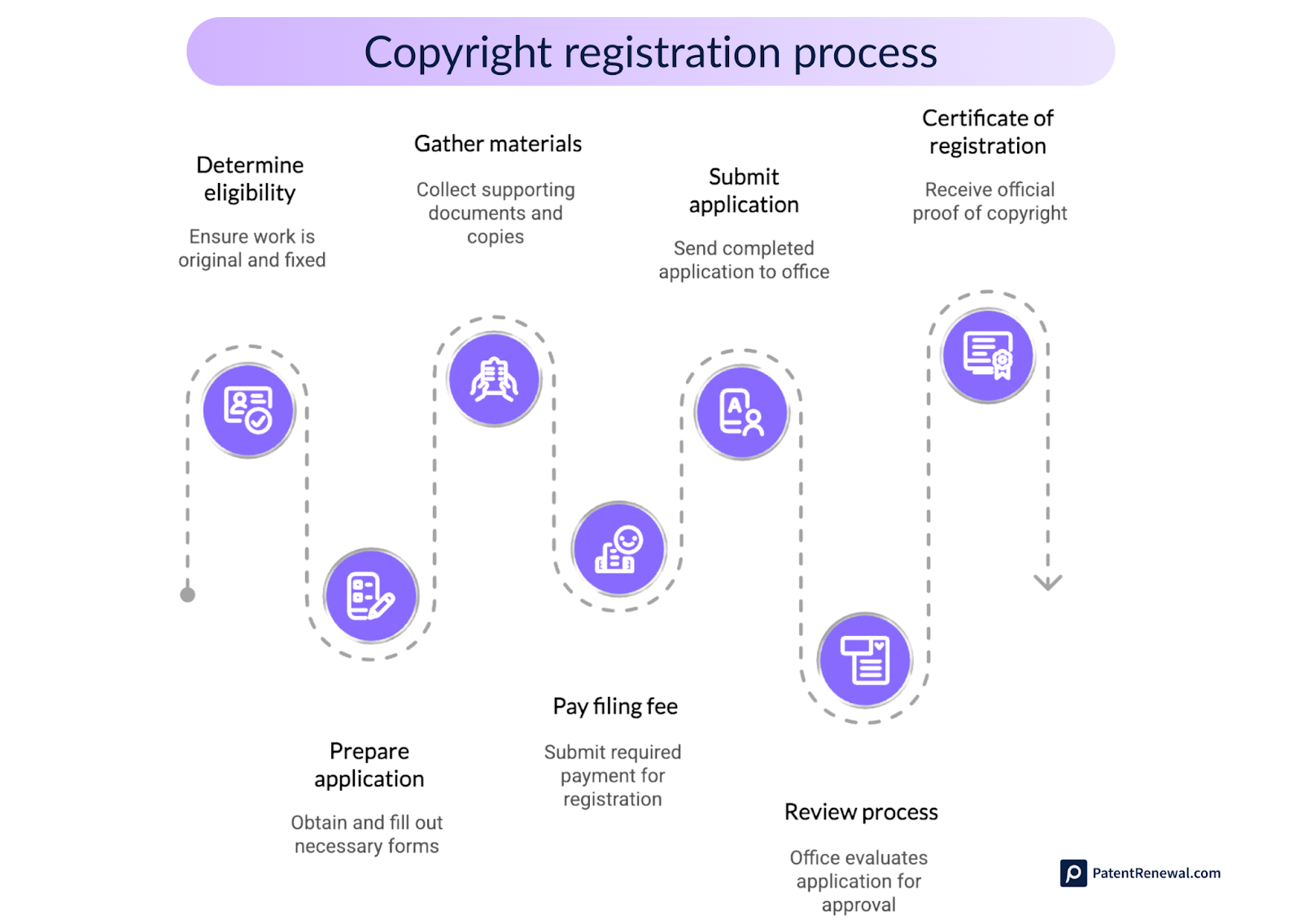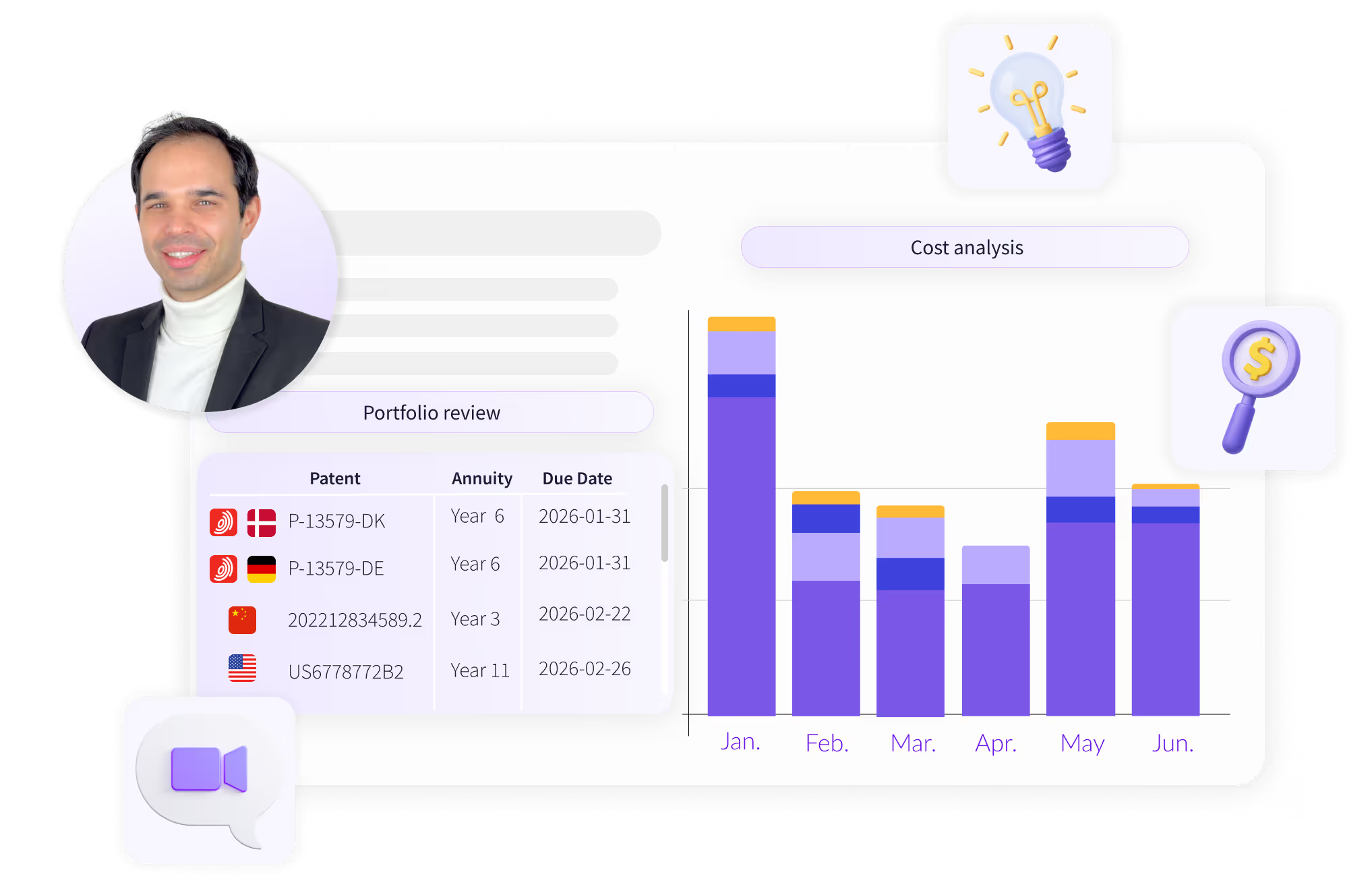TRY OUR NEW (FREE) IP RENEWAL COST CALCULATOR
Calculate.avif)
Copyrights play a crucial role in protecting your creative works, whether you're an artist, writer, musician, or inventor. It's more than just a legal term; copyright allows you to maintain control over your creations.
This guide will cover the basics of copyright law, from registration to enforcement and its global implications. By the end, you’ll understand how to safeguard your creations and manage your IP more effectively, as well as key facts, including:
Copyright is a form of intellectual property (IP) that grants creators exclusive rights to their original works. Copyright keeps creators from having their work used without permission.
Copyright covers a broad range of creative works, including:

Copyright protects the expression of ideas, not the ideas themselves. A novel about a detective solving a mystery is protected by copyright, but the general idea of a detective solving crimes is not.
Copyright plays a significant role in the global economy. According to WIPO, creative industries generate trillions of dollars in revenue every year. Sectors like music, film, and publishing serve as major economic drivers, supporting millions of jobs worldwide. Protecting creators’ rights ensures they can continue to invest in their work, leading to long-term economic growth.
Copyright is crucial for creators because it ensures that their work is recognized and protected. Without copyright, anyone could reproduce, distribute, or modify your work without your permission. Copyright gives creators control over their work’s use, whether it's for commercial, personal, or educational purposes. This legal control enables creators to profit from their efforts and decide who can benefit from their work.
Copyright also drives innovation. By securing the rights to their work, creators are encouraged to continue investing in new, original creations, which benefits the economy and society.
To qualify for copyright protection, a work must meet two requirements:
Once these criteria are met, the work is automatically protected by copyright in most countries, although registration provides additional legal benefits.
Beyond the basic requirements a work must meet to qualify for copyright, there are other important legal aspects that guide how copyright works, what it protects, and its limits. Key principles include:
These principles ensure that creators can protect their original ideas and control how others use their work.
As a copyright holder, you have a bundle of exclusive rights. These rights give you control over how others use your work and allow you to earn from it:

You can also license these rights to others, which allows you to earn revenue while retaining control over how your work is used.
While copyright protection is automatic as soon as a work is created and fixed in a tangible form, registering the work with the appropriate government office provides numerous advantages. Registration serves as evidence of ownership, making it easier to protect your rights, especially in cases of infringement.
Registering your copyright grants several key benefits:
Registering a copyright generally requires the following:

The registration process is simple but can vary by jurisdiction. There’s no single international registration, so if you want registration in multiple countries, you have to apply and pay separately in each one. Many countries now offer online registration to simplify the process.
Copyright protection doesn't last indefinitely. Generally, it lasts for the life of the author plus 50 to 70 years, depending on the jurisdiction. For joint works, copyright extends for 70 years after the death of the last surviving author.
Some countries go beyond these limits, Guatemala, Honduras, and Samoa set the term at life + 75 years, Colombia and Equatorial Guinea extend it to life + 80 years, Jamaica offers life + 95 years, and Mexico grants the longest term at life + 100 years.
Under the US copyright law, works made for hire, anonymous, or pseudonymous works protection typically lasts for 95 years from the date of publication or 120 years from creation, whichever comes first. These terms refer to works created under an employer’s ownership or published without the author’s real name, either anonymously or under a fake name.
These standards ensure that creators and their heirs maintain control over their works for a significant period, offering a balance between individual rights and public use.
Once copyright protection expires, the work enters the public domain. This means that anyone can use, reproduce, adapt, and share the work without needing permission or paying royalties. Public domain works are a valuable resource for research, education, and creative reuse, as they contribute to the cultural and educational landscape.
For example, works created before 1926 in the U.S. have entered the public domain, such as F. Scott Fitzgerald’s The Great Gatsby. Now, anyone could legally publish, adapt, or remix the novel without paying licensing fees or seeking permission.
Some works have specific protection durations. For example:
Copyright operates globally under international agreements like the Berne Convention, which sets a minimum term of protection (life of the author + 50 years) and requires national treatment, meaning foreign authors receive the same protection as domestic ones. While most countries do not require formal registration to secure rights, many offer national copyright registration systems to create public records and strengthen enforcement.
For certain types of works, international agreements like the WIPO Copyright Treaty (WCT) for digital works and the WIPO Performances and Phonograms Treaty (WPPT) for sound recordings and performances set common standards that ensure protection across member countries. The TRIPS Agreement further strengthens enforcement in all World Trade Organization (WTO) member states, helping creators secure rights in multiple jurisdictions.
Copyright isn’t absolute. Fair use (in the U.S.) and fair dealing (in other jurisdictions) provide exceptions to copyright. These exceptions allow others to use copyrighted works without permission for specific purposes, such as:
The extent of these exceptions depends on factors such as the reason for your use of the work, how much of it you use, and whether your use affects the market for the original work. As a general rule, you should only use the portion necessary for your purpose, and your use should add new meaning, context, or value.
These exceptions ensure that copyright laws balance the creator’s rights with the public's access to ideas, education, and free expression.
In some countries, copyright includes moral rights, which protect the personal and reputational connection an author has with their work. These rights typically include:
Moral rights are especially important for artists and authors who want to maintain control over how their works are presented to the public.
Copyright owners can grant others the right to use their work through licenses. There are two main types:
These licenses can cover territory, duration, and specific uses, including licensing for film, advertising, or online distribution.
Creators can also transfer their copyright to others via assignments. These contracts allow the creator to sell or assign their rights to companies, publishers, or other entities in exchange for a lump sum or ongoing royalties.
Copyright infringement happens when someone uses a copyrighted work without the creator’s permission or without a legal exception. This can include:

In the digital age, infringement is especially common, with online platforms making it easy to copy and distribute content.
To enforce your copyright, you have a few options:
Copyright is often discussed alongside patents, trademarks, and trade secrets, but it serves a different purpose. Patents protect inventions or processes, while trademarks protect brands and logos. Trade secrets protect confidential business information, like formulas or practices.
Copyright, however, focuses on protecting the expression of ideas rather than the ideas themselves. For instance, a patent could protect the technology behind a new product, while copyright could protect the creative expression around it, such as the product’s written story, marketing materials, or decorative design elements.
Understanding how copyright fits alongside patents, trademarks, and trade secrets gives you the full picture of protecting your intellectual property. If your portfolio also includes patents, trademarks, managing IP renewals efficiently is just as important as securing the rights in the first place.
PatentRenewal.com offers an efficient, cost-effective way to handle your IP renewals, all while saving you up to 50% on renewal costs. Sign up today to take control of your intellectual property with our easy-to-use platform.
Interested in a free IP renewal consultation? Benchmark your current IP renewal setup and costs against market standards.
